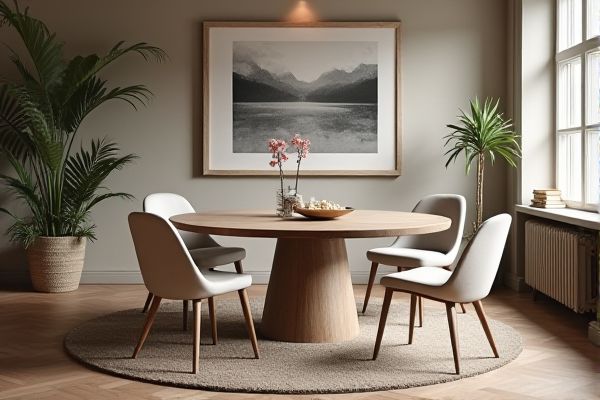
Round tables encourage more intimate and equal conversations by allowing everyone to face each other, while rectangular tables provide a more structured seating arrangement ideal for formal settings or larger groups. Discover which table shape best suits Your space and social needs by reading the rest of the article.
Table of Comparison
| Feature | Round Table | Rectangular Table |
|---|---|---|
| Shape | Circular | Four-sided, rectangular |
| Seating Capacity | Ideal for 4-8 people | Suitable for 6-12+ people |
| Space Efficiency | Better for small spaces, promotes interaction | Better for large rooms, fits against walls |
| Interaction | Equal interaction, everyone faces each other | Less interaction for long tables, head of table dominates |
| Use Case | Casual dining, meetings with equal participation | Formal dining, large group meetings |
| Design Versatility | Limited tabletop space | More surface area for dishes, decorations |
Introduction to the Round Table vs Rectangular Table Debate
Round tables promote easier conversation and equal participation by eliminating head positions, making them ideal for collaborative settings and social gatherings. Rectangular tables offer clear seating arrangements and accommodate more guests in formal dining or conference environments where hierarchical seating is preferred. Choosing between round and rectangular tables depends on the desired interaction style, space constraints, and the event's purpose.
Space Efficiency: Round vs Rectangular Tables
Round tables maximize space efficiency by allowing more flexible seating arrangements and promoting better flow in smaller or irregularly shaped rooms. Rectangular tables often require more linear space and can create unused corners, making them less ideal for compact areas. In environments with limited space, round tables optimize occupancy while maintaining comfort and accessibility.
Seating Capacity Comparison
Round tables typically accommodate fewer people, comfortably seating 4 to 8 individuals, making them ideal for small gatherings and promoting intimate conversations. Rectangular tables can seat larger groups, often ranging from 6 to 12 or more, depending on their length, making them suitable for formal dining or business meetings. The choice between round and rectangular tables directly impacts seating capacity and social interaction dynamics within a space.
Aesthetics and Style Considerations
Round tables enhance aesthetics by creating a harmonious and balanced look, promoting fluidity in design and encouraging social interaction through equal seating arrangements. Rectangular tables offer a more formal and structured appearance, complementing traditional or contemporary interiors with clean, linear lines that define space clearly. Selecting between round and rectangular tables depends on the desired ambiance, with round tables fostering intimacy and rectangular tables emphasizing elegance and order.
Social Interaction and Conversation Flow
Round tables enhance social interaction by allowing all participants to face each other equally, promoting open conversation flow and inclusiveness. Rectangular tables often create a hierarchical seating arrangement, which may inhibit equal participation and limit dynamic dialogue. Choosing the right table shape can significantly impact how your group communicates and connects during gatherings.
Versatility for Different Room Layouts
Round tables offer enhanced versatility for various room layouts due to their symmetrical shape, allowing easier movement and accommodation in tighter or irregular spaces. Rectangular tables excel in longer, narrow rooms by maximizing seating capacity along the table's edges, fitting well against walls or in dining rooms with defined dimensions. Choosing between round and rectangular tables depends on spatial constraints and the desired flow of movement within the room.
Functionality: Dining, Meetings, and Beyond
Round tables promote equal interaction and easy conversation, making them ideal for collaborative meetings and intimate dinners where everyone can engage. Rectangular tables offer distinct head positions, supporting hierarchical seating arrangements commonly used in formal dining and structured meetings. Your choice should reflect the desired atmosphere and functionality, whether fostering inclusivity or emphasizing order.
Maintenance and Cleaning Differences
Round tables typically require less maintenance as they have fewer corners where dust and debris accumulate, making cleaning faster and more efficient. Rectangular tables often demand more frequent attention to corners and edges, where dirt and spills can collect, necessitating thorough wiping and corner-specific cleaning tools. Materials and finish also play a crucial role, with smoother surfaces on round tables easing stain removal compared to textured or grooved rectangular tables.
Cost and Material Availability
Round tables often cost more than rectangular tables due to their complex manufacturing process and the greater amount of material needed to create a continuous curved edge. Rectangular tables typically benefit from widespread material availability and standard sizes, making them more cost-effective and easier to source. Materials like solid wood, plywood, and MDF are commonly available in dimensions suited for rectangular tables, reducing waste and production expenses.
Choosing the Right Table for Your Needs
Round tables promote equal interaction and maximize seating in smaller spaces, making them ideal for intimate gatherings or collaborative work. Rectangular tables provide defined seating arrangements and accommodate more people in longer rooms, suiting formal meetings or dining settings. Assess your room layout and social dynamics to choose the right table that enhances your space's functionality and style.
 homyna.com
homyna.com